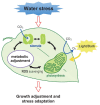Response of plants to water stress
- PMID: 24659993
- PMCID: PMC3952189
- DOI: 10.3389/fpls.2014.00086
Response of plants to water stress
Abstract
Water stress adversely impacts many aspects of the physiology of plants, especially photosynthetic capacity. If the stress is prolonged, plant growth, and productivity are severely diminished. Plants have evolved complex physiological and biochemical adaptations to adjust and adapt to a variety of environmental stresses. The molecular and physiological mechanisms associated with water-stress tolerance and water-use efficiency have been extensively studied. The systems that regulate plant adaptation to water stress through a sophisticated regulatory network are the subject of the current review. Molecular mechanisms that plants use to increase stress tolerance, maintain appropriate hormone homeostasis and responses and prevent excess light damage, are also discussed. An understanding of how these systems are regulated and ameliorate the impact of water stress on plant productivity will provide the information needed to improve plant stress tolerance using biotechnology, while maintaining the yield and quality of crops.
Keywords: abiotic stress; biomass; drought stress; photosynthesis; reactive oxygen species; stomatal closure.
Figures


References
-
- Bai L., Zhang G., Zhou Y., Zhang Z., Wang W., Du Y., et al. (2009). Plasma membrane-associated proline-rich extensin-like receptor kinase 4, a novel regulator of Ca signalling, is required for abscisic acid responses in Arabidopsis thaliana. Plant J. 60 314–327 10.1111/j.1365-313X.2009.03956.x - DOI - PubMed
Publication types
LinkOut - more resources
Full Text Sources
Other Literature Sources

